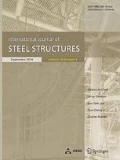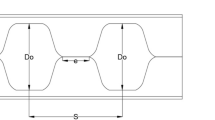Abstract
Steel structures are subjected to corrosion due to environmental exposure and inadequate maintenance. As a result, the carrying capacity and hence the level of safety of this structures diminishes with time due to accumulation of corrosion damage (e.g. section loss). For the assessment of the remaining moment capacity of corrosion damaged I-beams, two methods have been proposed in this paper based on the thickness loss data were compiled from four corroded damaged I-beams, namely the simple and accurate assessment methods. These methods give the quantitative relationship between the magnitude of structural defects (loss of thickness) and the corresponding remaining moment capacity (expressed as percentage of the as-new strength) of corrosion damaged beams. These methods require only the information regarding thickness loss of the appropriate elements of the members (flanges and web) and the capacity of the beam in its as-new condition, to assess the remaining moment capacity of a corrosion damaged beam. The thickness loss information can be provided by visual inspection or thickness measurement of a member. These assessment methods will help the practicing engineer to make a fast and reliable decision regarding the remaining moment capacity of corrosion damaged I-beam.
Similar content being viewed by others
References
Albrecht, P. and Naeemi, A. H. (1984).Performance of weathering steel in bridges. National Cooperative Highway Research Program, Report 272, Transportation Research Board, National Research Council, Washington, DC.
BS 5950 (1985).Structural use of steel work in building. Part 1, Code of Practice for Design in Simple and Continuous Construction, Hot Rolled Sections, British Standard Institution, London, UK.
Czarnecki, A. A. and Nowak, A. S. (2008). “Time-variant reliability profiles for steel girder bridges.”Structural Safety, 30(1), pp. 49–64.
Fontana, M. G. (1987).Corrosion engineering. McGraw Hill Book Company, New York, N.Y., USA.
Gallon, M. J. (1993).Managing structural corrosion in chemical plants. New Steel Construction, ICI Engineering, UK.
Horne, M. R. (1971).Plastic theory of structure. Thomas Melson and Sons, Ltd., England.
Johnston, B. G. (1976).Guide to stability design criteria for metal structures. Third Edition, John Wiley & Sons, New York, USA.
Kayser, J. R. and Nowak, A. S. (1987). “Evaluation of corroded steel bridges.”Proc. Structures Congress Related to Bridge and Transmission Line Structures, American Society of Civil Engineers, Orlando, Florida, pp. 35–47.
Kayser, J. R. and Nowak, A. S. (1989). “Capacity loss due to corrosion in steel-girder bridges.”Journal of Structural Engineering, ASCE, 115(6), pp. 1525–1537.
Koch, G. H., Brongers, M. P. H., Thompson, N. G., Virmani, Y. P., and Payer, J. H. (2002).Corrosion cost and preventive strategies in the United States. Report. No. FHWA-RD-01-156, Office of Infrastructure Research and Development, Federal Highway Administration, Mclean, VA, USA.
Komp, M. E. (1987). “Atmospheric corrosion rating of weathering steel-calculations and significance.”Materials Performance, 26(7), pp. 42–44.
Kulicki, J. M., Prucs, Z., Sorgenfrei, D. F., and Mertz, D. R. (1990).Guidelines for evaluating corrosion effects in existing steel bridges, National Cooperative Highway Research Program, Report No. 333, Transportation Research Board, National Research Council, Washington, DC.
Lay, M. G. (1950). “Flange local buckling in wide-flange shape.Journal of the Structural Division, ASCE, 91(6), pp. 95–116.
Rahgozar, R. and Smith, J. W. (1997). “Fatigue endurance of steel structures subjected to pitting corrosion.Proc. Fourth International Conference on Civil Engineering, Sharif University of Technology, Iran, pp. 237–246.
Rahgozar, R. (1998).Fatigue endurance of steel structures subjected to corrosion. PhD Thesis, Department of Civil Engineering, University of Bristol, UK.
Rahgozar, R., Khalaghi, A. R., and Javanmardi, R. (2006). “Fatigue notch factor in steel bridges due to corrosion.”Proc. Seventh International Congress on Civil Engineering, Tarbiat Modares University, Tehran, Iran, pp. 46–53.
Rahgozar, R. (2009). “Remaining capacity assessment of corrosion damaged beams using minimum curves.”Journal of Constructional Steel Research, 65(2), pp. 299–307.
Stowell, E. Z., Heimerl, G. J., Libove, C., and Lundquist, E. E. (1952). “Buckling stresses for flat plates and sections.”Transaction of ASCE, 117, pp. 545–578.
Timoshenko, S. P. and Gere, J. M. (1961).Theory of elastic stability. McGraw-Hill Book Co., Inc., New York, N. Y., USA.
Townsend, H. E. and Zoccola, J. C. (1982). “Eight year atmospheric corrosion performance of weathering steel in industrial rural and marine environments.”Atmospheric Corrosion of Metals, American Society for Testing and Materials, 767, pp. 45–59.
Trahair, N. S., Bradford, M. A., and Nethercot, D. A. (2001).The behavior and design of steel structures to BS5950, Third Edition-British. Spon Press, Taylor & Francis Group, London.
Author information
Authors and Affiliations
Corresponding author
Rights and permissions
About this article
Cite this article
Sharifi, Y., Rahgozar, R. Remaining moment capacity of corroded steel beams. International Journal of Steel Structures 10, 165–176 (2010). https://doi.org/10.1007/BF03215828
Received:
Accepted:
Issue Date:
DOI: https://doi.org/10.1007/BF03215828




